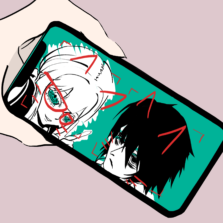
With a picture of Kokichi Ouma in their mind, senior Koki Barrera applies black eyeliner around their eyes. They tinker with the black and purple wig they’ve been styling all week. Kokichi’s checkered undershirt and suit look better in the cosplay than they had originally anticipated.
Barrera is participating cosplay, an activity where one dresses up as a fictional character in a movie, book, show or video game. For nearly five years, Barrera has been reputed for their cosplay of the character Kokichi Ouma from the anime series “Danganronpa.”
“Kokichi Ouma is a controversial character. … His motivations in the story are hard to figure out because he likes to lie a lot,” Barrera said. “I cosplay him because he’s fun to act as, and I enjoy people’s reactions to seeing me dressed as him.”
Getting into cosplay usually takes multiple hours.
“[Cosplay] can be anything from just a makeup look to an entire thing with props,” said senior Lydia Zawilski.
While some choose to make their own props and costumes, others buy the necessary accessories. Either way, cosplaying can be expensive. Since the COVID-19 pandemic, many cosplayers have lost their steady source of income, leading them to cosplay less frequently than they want to.
“It’s transform[ing] into another character who impact[s] their story”
Conventions are major events in the cosplay community. They are the perfect way to form connections with photographers who show off the cosplay they spent so much time putting together.
“I like the social aspect [of cosplaying], going to conventions and meeting different people,” Barrera said. “It’s all really fun. I’ve made a lot of friends through cosplaying. We hang out regularly outside of cosplaying.”
In the wake of COVID-19, cosplayers wonder when the next convention will take place. Until then, they rely on social media to showcase their cosplays.
TikTok and Instagram are the two main platforms that cosplayers use. Instagram gives off a more professional look, whereas TikTok provides instant content.
“It’s very easy to share and to spread and grow [on Instagram and] TikTok,” Zawilski said. “A lot of people can relate to TikTok being a creator-friendly platform [for cosplayers].”
On TikTok, junior Addison Cornwall witnesses the drama within the cosplay community, where some cosplayers receive hate from after taking inspiration from someone else without properly crediting the original cosplayer.
“[Social media is] a little bit of pressure sometimes,” Cornwall said. “I have a friend … [who] decided to start over completely from scratch because she didn’t want a ton of people seeing her [posts].”
Still, the cosplay community on social media is primarily a source of inspiration, encouragement and support.
“Some people have told me that I am their favorite cosplayer, that they look up to me and [that] I inspire them to do cosplay,” Cornwall said. “That’s super nice.”
A supportive environment is important, for many cosplayers struggle with the stigma associated with cosplay.
“[People] think that if someone cosplays they’re weird or outcasts,” Zawilski said. “When I started cosplaying, I was afraid of [the] backlash or what people would think of me, but in recent years, I’ve just [decided] … to be open about [cosplay] being my hobby and my passion.”
Cosplaying is a form of artistic expression, and it is more mainstream than people may realize. Despite only being a hobby, cosplaying has changed the lives of many people, especially for the many high school students who struggle with identity and body image.

“[Cosplay] definitely helped with self-image a lot,” Zawilski said. “Even putting on a bunch of makeup and being someone that you’re not somehow helps me personally get so much more comfortable with my own face [and] body image.”
Like other creative outlets, cosplayers can also use cosplay as an escape.
“It’s probably my biggest passion,” Zawilski said. “[Cosplay] appeals to a lot of people who [may be] struggling with mental health, have physical disabilities, are neurodivergent or LGBT. [It’s] the idea of being able to transform yourself into another character who has an impact in their own story.”
With the growing attention that cosplay receives on social media, there is hope that it will lose its stigma and become more accepted.




